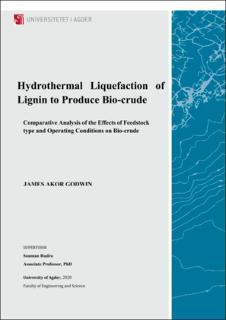| dc.contributor.author | Godwin, James Akor | |
| dc.date.accessioned | 2020-03-09T09:03:53Z | |
| dc.date.available | 2020-03-09T09:03:53Z | |
| dc.date.issued | 2019 | |
| dc.identifier.uri | https://hdl.handle.net/11250/2645940 | |
| dc.description | Master's thesis Renewable Energy ENE500 - University of Agder 2019 | en_US |
| dc.description.abstract | Lignin is one of the most abundant non-food biomass resources in the world today andseveral attempts are ongoingto harness its huge potential. Due to its rigid structure however, different processes are being experimented on how best todepolymerize it and maximizeits product streams. Some companies like Borregarrd have recorded successes in recent time,on producing vanillin from ligninusing a catalytic oxidation process, but still acknowledge that more products can be obtained from it. Hence, their quest to investigatethe energy potential of one of the lignin types in their product line; Lignosulfonate. The challenge is therefore how best to depolymerize this lignin for energy production in a cost effective and environmentally friendly manner. The objective of this work was to explore the use of hydrothermal liquefaction process to depolymerize the lignosulfonate from Borregarrd as well as alkali lignin from Sigma-Aldrich, for production of bio-crude and compare the effect of the feedstock on the yield and quality of bio-crude produced and other potential energy recovery product that may arise from the process. Hydrothermal Liquefaction(HTL)is one of thethermochemical processesfor conversion of biomassthat has gained considerable attention in recent timesdue to its lower energy consumption when compared to other thermochemical processes. Thisliquefaction was performed in a batch system at sub-critical conditions without a catalyst,and results showed that alkali lignin producedyield of 21% bio-crude at 300oC in comparison with lignosulfonate with 9% bio-crude. The bio-crude yield tend to decrease with increasing temperature and vise-versa.The bio-char on the other hand, tend to increase in yieldwith increasing temperature.The bio-char from alkali lignin showed higher carbon and energy recovery of 38.5 % and 19.54%, compared to 6.3% than the 6.28% from lignosulfonate. The results from this work has demonstratedthat lignosulfonate has some energy potential but the use ofcatalystwill be necessary to fully tapits energy potential, though at an extra cost.Future work on the HTLprocess,should be geared towards a comprehensive LCA study to properly quantify its environmental impacts in comparison with other thermochemical processes. | en_US |
| dc.language.iso | eng | en_US |
| dc.publisher | Universitetet i Agder ; University of Agder | en_US |
| dc.rights | Attribution-NonCommercial-NoDerivatives 4.0 Internasjonal | * |
| dc.rights.uri | http://creativecommons.org/licenses/by-nc-nd/4.0/deed.no | * |
| dc.subject | ENE500 | en_US |
| dc.title | Hydrothermal Liquefaction of Lignin to Produce Bio-crude : Comparative Analysis of the Effects of Feedstock type and Operating Conditionson Bio-crude | en_US |
| dc.type | Master thesis | en_US |
| dc.subject.nsi | VDP::Teknologi: 500 | en_US |
| dc.source.pagenumber | 89 p. | en_US |

